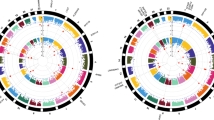Abstract
Objective:
The aim of this study was to determine whether genetic variation at the cannabinoid receptor-1 (CNR1) locus could have an effect on adiposity, fat distribution and obesity-related metabolic disorders in Polish postmenopausal women.
Design and Subjects:
The A3813G (rs12720071), G1422A (rs1049353), A4895G (rs806368) and rs806381, rs10485170, rs6454674 and rs2023239 single-nucleotide polymorphisms of CNR1 were genotyped in 348 randomly selected postmenopausal women aged 50–60 years recruited from the Wroclaw city population.
Measurements:
CNR1 genotypes, anthropometric measures (body mass index (BMI), waist circumference (WC) and body fat distribution by dual energy X-ray absorptiometry) and metabolic parameters (glucose, lipid profile and Fasting Insulin Resistance Index for insulin resistance) were determined.
Results:
The 3813G allele was not significantly associated with higher body mass, BMI, WC, total fat or fat percentage, but was associated with higher android fat deposit (2971.78±1655.08 vs 2472.64±1300.53, P=0.007) and percentage of android fat (37.59±8.45 vs 35.66±7.63, P=0.062). No associations for the G1422A, A4895G, rs806381, rs10485170, rs6454674 and rs2023239 variants were observed.
Conclusions:
There is an association of the variants of CNR1 with obesity-related phenotypes in Polish postmenopausal women. As cannabinoid receptor type 1 is a drug target for obesity, pharmacogenetic receptor gene analysis of obesity treatment by endocannabinoid blockade may be of interest to identify the best responders.
This is a preview of subscription content, access via your institution
Access options
Subscribe to this journal
Receive 12 print issues and online access
$259.00 per year
only $21.58 per issue
Buy this article
- Purchase on Springer Link
- Instant access to full article PDF
Prices may be subject to local taxes which are calculated during checkout
Similar content being viewed by others
References
Milewicz A, Tworowska U, Demissie M . Menopausal obesity - myth or fact? Climacteric 2001; 4: 273–283.
Di Marzo V, Bifulco M, De Petrocellis L . The endocannabinoid system and its therapeutic exploitation. Nat Rev Drug Discov 2004; 3: 771–784.
Pagotto U, Vicennati V, Pasquali R . The endocannabinoid system and the treatment of obesity. Ann Med 2005; 37: 270–275.
Di Marzo V, Matias I . Endocannabinoid control of food intake and energy balance. Nat Neurosci 2005; 8: 585–589.
Pagotto U, Marsicano G, Cota D, Lutz B, Pasquali R . The emerging role of the endocannabinoid system in endocrine regulation and energy balance. Endocr Rev 2006; 27: 73–100.
Osei-Hyiaman D, Harvey-White J, Batkai S, Kunos G . The role of the endocannabinoid system in the control of energy homeostasis. Int J Obes 2006; 30: S33–S38.
Zhang PW, Ishiguro H, Ohtsuki T, Hess J, Carillo F, Walther D et al. Human cannabinoid receptor 1:5_exons, candidate regulatory regions, polymorphisms, haplotypes and association with polysubstance abuse. Mol Psychiatry 2004; 9: 916–931.
Russo P, Strazzullo P, Cappuccio FP, Tregouet DA, Lauria F, Loguercio M et al. Genetic variations at the endocannabinoid type 1 receptor gene (CNR1) are associated with obesity phenotypes in men. J Clin Endocrinol Metab 2007; 92: 2382–2386.
Peeters A, Beckers S, Mertens I, Van Hul W, Van Gaal L . The G1422A variant of the cannabinoid receptor gene (CNR1) is associated with abdominal adiposity in obese men. Endocrine 2007; 31: 138–141.
Benzinou M, Chévre JC, Ward KJ, Lecoeur C, Dina C, Lobbens S et al. Endocannabinoid receptor 1 gene variations increase risk for obesity and modulate body mass index in European populations. Hum Mol Genet 2008; 17: 1916–1921.
Greenfield JR, Samaras K, Chisholm DJ . Insulin resistance, intra-abdominal fat, cardiovascular risk factors, and androgens in healthy young women with type 1 diabetes mellitus. J Clin Endocrinol Metab 2002; 87: 1036–1040.
Wajchenberg BL . Subcutaneous and visceral adipose tissue: their relation to the metabolic syndrome. End Rev 2000; 21: 637–738.
Van Gaal LF, Rissanen AM, Scheen AJ, Ziegler O, Rossner S, RIO-Europe Study Group. Effects of the cannabinoid-1 receptor blocker rimonabant on weight reduction and cardiovascular risk factors in overweight patients: 1-year experience from the RIO-Europe study. Lancet 2005; 365: 1389–1397.
Despres JP, Golay A, Sjostrom L, Rimonabant in Obesity-Lipids Study Group. Effects of rimonabant on metabolic risk factors in overweight patients with dyslipidemia. N Engl J Med 2005; 353: 2121–2134.
Pi-Sunyer FX, Aronne LJ, Heshmati HM, Devin J, Rosenstock J, RIO-North America Study Group. Effect of rimonabant, a cannabinoid-1 receptor blocker, on weight and cardiometabolic risk factors in overweight or obese patients: RIO-North America: a randomized controlled trial. JAMA 2006; 295: 761–775.
Jaeger JP, Mattevi VS, Callegari-Jacques SM, Hutz MH . Cannabinoid type-1 receptor gene polymorphisms are associated with central obesity in a Southern Brazilian population. Dis Markers 2008; 25: 67–74.
Gazzerro P, Caruso MG, Notarnicola M, Misciagna G, Guerra V, Laezza C et al. Association between cannabinoid type-1 receptor polymorphism and body mass index in a southern Italian population. Int J Obes (Lond) 2007; 31: 908–912.
Lieb W, Manning AK, Florez JC, Dupuis J, Cupples LA, McAteer JB et al. Variants in the CNR1 and the FAAH genes and adiposity traits in the community. Obesity 2009; 17: 755–760.
Siani A, Strazzullo P . Tackling the genetic bases of metabolic syndrome: a realistic objective? Nutr Metab Cardiovasc Dis 2006; 5: 309–312.
Blakemore AIF, Froguel P . Is obesity our genetic legacy? J Clin Endocrinol Metab 2008; 93: S51–S56.
Aberle J, Flitsch J, Beck NA, Mann O, Busch P, Peitsmeier P et al. Genetic variation may influence obesity only under conditions of diet: analysis of three candidate genes. Mol Genet Metab 2008; 95: 188–191.
Acknowledgements
The work was supported by the grant number ST-143 of the Polish Ministry of Sciences.
Author information
Authors and Affiliations
Corresponding author
Ethics declarations
Competing interests
The authors declare no conflict of interest.
Rights and permissions
About this article
Cite this article
Milewicz, A., Tworowska-Bardzińska, U., Jędrzejuk, D. et al. Are endocannabinoid type 1 receptor gene (CNR1) polymorphisms associated with obesity and metabolic syndrome in postmenopausal Polish women?. Int J Obes 35, 373–377 (2011). https://doi.org/10.1038/ijo.2010.145
Received:
Revised:
Accepted:
Published:
Issue Date:
DOI: https://doi.org/10.1038/ijo.2010.145



